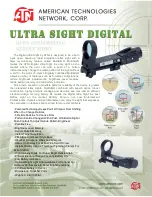
6
NOTE: The image in the telescope will appear reversed
left-to-right). This is normal for astronomical telescopes
that utilize a star diagonal. The finder scope view will be
rotated 180° (see Figure 5).
If you have trouble focusing, rotate the focusing knob so the
drawtube is in as far as it will go. Now look through the eye-
piece while slowly rotating the focusing knob in the opposite
direction. You should soon see the point at which focus is
reached.
The metal thumb screw on the top of the body of the focuser
will lock the focuser drawtube in place once the telescope is
properly focused. Before focusing, remember to first loosen
this thumb screw.
Viewing with Eyeglasses
If you wear eyeglasses, you may able to keep them on while
you observe, if the eyepiece has enough “eye relief” to allow
you to see the whole field of view. You can try this by looking
through the eyepiece first with your glasses on, and then with
them off, and see if the glasses restrict the view to only a por-
tion of the full field. If they do, you can easily observe with your
glasses off by just re-focusing the telescope the needed
amount. If you suffer from severe astigmatism, however, you
may find images noticeably sharper with your glasses on.
Aligning the Finder Scope
The SkyView Pro 100 EQ comes with a 6x30 achromatic find-
er scope (Figure 3a). The number 6 means six-times magnifi-
cation and the 30 indicates a 30mm diameter front lens. The
finder scope makes it easier to locate the subject you want to
observe in the telescope, because the finder scope has a
much wider field-of-view.
The finder scope uses a spring-loaded bracket that makes
alignment of the finderscope very easy. As you turn either of
the thumbscrews, the spring in the bracket’s tensioner moves
in and out to keep the finder scope secure in the bracket.
The finder scope must be aligned accurately with the tele-
scope for proper use. To align it, first aim the main telescope
at an object at least a 1/4 mile away—the top of a telephone
pole, a chimney, etc. First loosen the R.A. and Dec. lock levers
and move the telescope until it is pointing towards the desired
object; sight along the tube to aim the telescope. Turn the
focus knob until the object is properly focused. Make sure to
position the object in the center of the telescope’s eyepiece by
turning the R.A. and declination slow-motion control knobs
(the R.A. and Dec. lock levers must be tightened to use the
slow-motion control knobs).
Now look in the finder scope. Is the object visible? Ideally it will
be somewhere in the field of view. If not, some coarse adjust-
ment to the finder scope bracket’s alignment thumbscrews will
be needed until the object comes into the finder scope’s field
of view.
With the image in the finder scope’s field of view, you now
need to fine-adjust the alignment thumbscrews to center the
object on the intersection of the crosshairs. Adjust the aim of
the finder scope by turning the thumbscrews, one at a time,
until the object is centered. Make sure the object is still cen-
tered in the telescope’s eyepiece as well. If it is not still cen-
tered in the eyepiece you will need to repeat the process.
The finder scope alignment needs to be checked before every
observing session. This can easily be done at night, before
viewing through the telescope. Choose any bright star or plan-
et, center the object in telescope eyepiece, and then adjust
the finder scope bracket’s alignment thumbscrews until the
star or planet is centered on the finder’s crosshairs.
Focusing the finder scope
If, when you look through the finder scope, the images appear
somewhat out of focus, you will need to refocus the finder
scope for your eyes. Loosen the lock ring located behind the
objective lens cell on the body of the finder scope (see Figure
3a). Back the lock ring off by a few turns, for now. Refocus the
finder scope on a distant object by threading the objective
lens cell in or out of the finderscope body. Precise focusing will
be achieved by focusing the finder scope on a bright star.
Once the image appears sharp, retighten the locking ring
behind the objective lens cell. The finder scope’s focus should
not need to be adjusted again.
Magnification & Eyepieces
Magnification, or power, is determined by the focal length of
the telescope and the focal length of the eyepiece. Therefore,
by using eyepieces of different focal lengths, the resultant
magnification can be varied.
Magnification is calculated as follows:
Telescope Focal Length (mm)
Magnification =
Eyepiece Focal Length (mm)
View through the SkyView Pro 100 EQ
Figure 5.
Images through the finder scope will appear
upside-down and backwards (rotated 180°). Images through the
SkyView Pro 100 EQ with its diagonal in place will be reversed from
left-to right.
View through finder scope
































